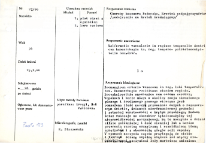Tytuł pozycji:
File of histopathological evaluation of nervous system diseases (1966) - nr 27/66
Clinical, anatomical and histological diagnosis
Rozpoznanie kliniczne, anatomiczne i histologiczne
Histological diagnosis: Haemangioma venous arteries in reg. temporal lobesAutopsy examination of 34-year-old patient was performed. Neuropathological evaluation in light microscopy was based on brain paraffin sections stained with H-E, Cresyl violet and Van Gieson's method.In the meninges and cerebral cortex in the area of the right superior and middle temporal ganglia, an increased number of vessels, mostly large, with dilated lumen, walls of inconsistent thickness and obliterated wall structure was seen. The wall structure indicated the arterio-venous nature of this vascular abnormality. The vessels had a highly fibrotic wall and quite thin or a very hypertrophied inner layer, with calcium salt deposits. Between the abnormal vessels was necrotic altered tissue with hemosiderin deposits. The medial part of the temporal lobe was destroyed by haemorrhage, and in this area after haematoma prolapse a 2x4.5cm cavity with ragged edges and residual blood remained, surrounded by necrotic tissue. Small and medium-sized interstitial vessels were seen in the frontal lobe. Particularly in the white matter they had walls of irregular thickness, with blurred structure. The lumen of other vessels was filled with a fibrous network, and the wall was completely fibrotic. Medium and large vessels were also fibrotic. Lymphocytic and lymphocytic-macrophage infiltrates with hemosiderin deposits were observed. The perivascular spaces were significantly dilated. Cellular defects were seen in the cortex and small foci of incomplete necrosis in the white matter was present.Histological diagnosis: Haemangioum arterio venoseum in reg. lobi temporalis dex. Haemorrhagia recidivans eiusdem reginis. Encephalopathia anoxaemica cum oedema cerebri.
Rozpoznanie histologiczne: Haemangioma venous arteries in.reg. temporal lobes. W oponach i korze mózgu w okolicy zwoju skroniowego górnego i środkowego prawego widoczna jest pomnożona ilość naczyń przeważnie dużych o rozszerzonym świetle, ścianach nierównomiernej grubości i zatartej warstwowości o krętym przebiegu. Budowa ścian wskazuje na charakter tętniczo-żylny tej nieprawidłowości naczyniowej. Są to naczynia o ścianie silnie zwłókniałej i dość cienkiej lub z bardzo przerosłą warstwą wewnętrzną i rozwłóknioną błoną sprężystą i z obecnością złogów soli wapnia.W oponach naczynia często przylegają do siebie i tworzą ścianę wspólną miąższu zaś między nieprawidlowymi naczyniami leży martwiczo zmieniona tkanka ze złogami hemosideryny. Część przyśrodkowa płata skroniowego została zniszczona przez krwotoki w miejecu tym po wypadnięciu krwi poztostała jama wielk. 2x4,5cm o brzegach postrzępionych z rosztkamikrwi otoczona tkanką martwiczp zmienioną. W płacie czołowym drobne i średnie naczynia śródmiąższowe szczególnie w istocie białej mają ściany nieregularnej grubości o zatartej strukturze z rozdętymi jądrami komórek, światło innych naczyń wypełnia sieć włóknika a ściana jest całkowicie zwłókniała. Zwłókniałe są też naczynia średniei duże naczyniówki. odczynowe limfocytarne, limfocytarno-makrofagowe zzawartością homosideryny, które przemawiają za równoczasowymi incydemtami pochodzenia naczyniowego.Przestrzenie okołonaczyniowe są znacznie poszerzone. W korze są ubytki komórkowe a w istocie białej gąbczaste i drobne ogniska martwicy niezupełnej.
